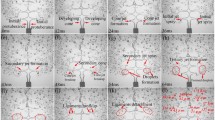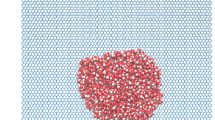Abstract
The microscopic evolution behavior of the interphase interaction between adjacent oppositely charged droplets in air and helium environments is investigated. By means of high-speed microscopy with high spatial and high temporal resolution, a special attention has been paid to the interphase morphology characteristics of oppositely charged droplets with different conductivities and applied voltages, and the dynamic evolution behaviors of noncontact bounce and noncontact breakup under the influence of gas ionization are discussed in detail. The results show that noncontact bounce occurs for low-conductivity droplets, whereas noncontact breakup occurs for high-conductivity droplets as the applied voltage increases gradually and that the occurrence of gas-phase ionization and reaching the Rayleigh limit dominate the changes of interphase interaction behaviors. Droplets of high conductivity mean greater minimum pole spacing when the noncontact bounce or breakup behavior occurs. With the increase of conductivity, the voltage required for noncontact breakup gradually decreases, while the occurrence of noncontact breakup behavior in a helium environment is relatedly lagging. Meanwhile, the minimum pole spacing of noncontact breakup is always greater than that in an air environment, and the changes of the minimum pole spacing in air and helium environments indirectly prove that the noncontact bouncing behavior of adjacent charged droplets is induced by gas ionization.
Graphic abstract
We introduce here the special interphase interaction of adjacent oppositely charged droplets. The occurrence of gas-phase ionization and reaching the Rayleigh limit dominate the changes of interphase interaction behaviors, and the significant differences of the minimum pole spacing d in air and helium environment indirectly prove that the noncontact bouncing behavior of adjacent charged droplets is induced by gas ionization.











Similar content being viewed by others
References
Bartlett CT, Généro GA, Bird JC (2015) Coalescence and break-up of nearly inviscid conical droplets. J Fluid Mech 763:369–385
Bock N, Dargaville TR, Woodruff MA (2012) Electrospraying of polymers with therapeutic molecules: state of the art. Prog Polym Sci 37:1510
Bird JC, Ristenpart WD, Belmonte A, Stone HA (2009) Critical angle for electrically driven coalescence of two conical droplets. Phys Rev Lett 103:164502
Chopey NP, Hicks TG (1984) Handbook of chemical engineering calculations. McGraw-Hill, New York
Gjorgievska EL, Nicholson JW, Grcev AT (2012) Ion migration from fluoride-releasing dental restorative materials into dental hard tissues. J Mater Sci Mater Med 23(7):1811–1821
Grace JM, Dunn PF (1996) Droplet motion in an electrohydrodynamic fine spray. Exp Fluids 20:153–164
Hamlin BS, Creasey JC, Ristenpart WD (2012) Electrically tunable partial coalescence of oppositely charged drops. Phys Rev Lett 109(9):094501
Huo YP, Wang JF, Zuo ZW, Fan YJ (2015) Visualization of the evolution of charged droplet formation and jet transition in electrostatic atomization. Phys Fluids 27:114105
Impey RW, Madden PA, Mcdonald IR (1983) Hydration and mobility of ions in solution. J Phys Chem 87(25):5071–5083
Jaworek A, Lackowski M, Krupa A, Czech T (2006) Electrostatic interaction of free EHD jets. Exp Fluids 40(4):568–576
John GL (1990) A simple demonstration of ion migration. J Chem Educ 67(12):1063
Lee MW, Kang DK, Yoon SS, Yarin AL (2012) Coalescence of two drops on partially wettable substrates. Langmuir 28(8):3791–3798
Li X, MacEwan MR, Xie JD, Siewe D, Yuan X (2010) Fabrication of density gradients of biodegradable polymer microparticles and their use in guiding neurite outgrowth. Adv Funct Mater 20(10):1632–1637
Liu T, Seiffert S, Thiele J, Abate AR, Weitz DA, Richtering W (2012) Non-coalescence of oppositely charged droplets in pH-sensitive emulsions. Proc Natl Acad Sci 109:384
Rayleigh L (1882) On the equilibrium of liquid conducting masses charged with electricity. Philos Mag 10:184–186
Ristenpart WD, Bird JC, Belmonte A, Dollar F, Stone HA (2009) Non coalescence of oppositely charged droplet. Nature 461(7262):377–380
Rossi NAA, West R (2009) Silicon containing liquid polymer electrolytes for application in lithium ion batteries. Polym Int 58(3):267–272
Varea A, Monereo O, Xuriguera E, Prades JD, Cirera A (2017) Electrospray as a suitable technique for manufacturing carbon-based devices. J Appl Phys 50(31):315301
Wang JF, Wang B, Qiu HH (2014) Coalescence and breakup of oppositely charged droplets. Sci Rep UK 4:7123
Wang XS, Wang GG, Li HY, Wang LY, Liu L, Guo XX, Wang H, Lian HW (2016) Fabrication and excellent formaldehyde gas sensing properties of Yb-doped In2O3 nanotubes. Acta Phys Sin 65(3):036802
Yue S, Liu XN, Shi ZG (2015) Experimental study on breakdown voltage between parallel plates in high-pressure helium. Acta Phys Sin 64(10):105101
Zhang J, He HZ (2012) The motion behavior of a group of charged droplets in liquid–liquid electrostatic spray. Flow Turbul Combust 89:675–689
Acknowledgements
This work was financed by the National Natural Science Foundation of China (no. 51706089), the Natural Science Foundation of Jiangsu Province (no. BK20160517), and the Postdoctoral Science Foundation of China (2016M601734). The authors appreciate their support for this work.
Author information
Authors and Affiliations
Corresponding author
Additional information
Publisher's Note
Springer Nature remains neutral with regard to jurisdictional claims in published maps and institutional affiliations.
Rights and permissions
About this article
Cite this article
Huo, Y., Zhang, C., Zuo, Z. et al. Effect of gas ionization on interphase interaction of adjacent oppositely charged droplets. Exp Fluids 61, 213 (2020). https://doi.org/10.1007/s00348-020-03047-w
Received:
Revised:
Accepted:
Published:
DOI: https://doi.org/10.1007/s00348-020-03047-w




